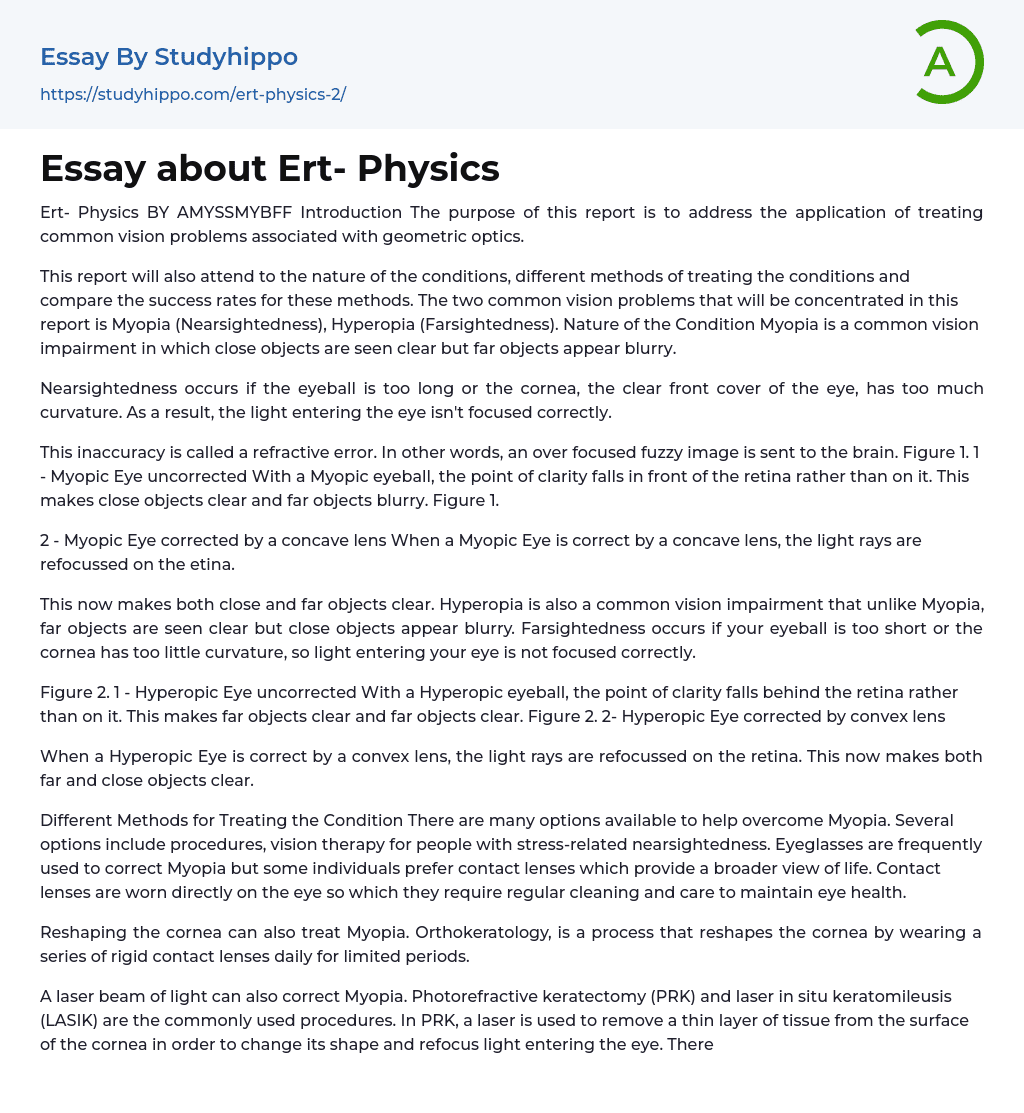This report will also attend to the nature of the conditions, different methods of treating the conditions and compare the success rates for these methods. The two common vision problems that will be concentrated in this report is Myopia (Nearsightedness), Hyperopia (Farsightedness). Nature of the Condition Myopia is a common vision impairment in which close objects are seen clear but far objects appear blurry.
Nearsightedness occurs if the eyeball is too long or the cornea, the clear front cover of the eye, has too much curvature. As a result, the light entering the eye isn't focused correctly.
This inaccuracy is called a refractive error. In other words, an over focused fuzzy image is sent to the brain. Figure 1. 1 - Myopic Eye uncorrected With a Myopic eyeball, the point of clarity falls in front of the retina rather than on it. This makes clo
...se objects clear and far objects blurry.
This now makes both close and far objects clear. Hyperopia is also a common vision impairment that unlike Myopia, far objects are seen clear but close objects appear blurry. Farsightedness occurs if your eyeball is too short or the cornea has too little curvature, so light entering your eye is not focused correctly.
When a Hyperopic Eye is correct by a convex lens, the light rays are refocussed on the retina. This now makes both far and close objects clear.
Different Methods for Treating the Condition There are many options available to help overcome Myopia. Several options include procedures, vision therapy for people with stress-related nearsightedness. Eyeglasses are frequently used to correct Myopia but some individuals prefer contact lenses which provide a broader view of life.
Contact lenses are worn directly on the eye so which they require regular cleaning and care to maintain eye health.
Reshaping the cornea can also treat Myopia. Orthokeratology, is a process that reshapes the cornea by wearing a series of rigid contact lenses daily for limited periods.
A laser beam of light can also correct Myopia. Photorefractive keratectomy (PRK) and laser in situ keratomileusis (LASIK) are the commonly used procedures. In PRK, a laser is used to remove a thin layer of tissue from the surface of the cornea in order to change its shape and refocus light entering the eye. There is a limit to how much tissue can safely be removed and therefore the amount of nearsightedness that can be corrected.
LASIK does not remove tissue from the surface of the cornea, but from its inner layers. To do this, a section of the outer corneal surface is cut and folded back to expose the inner tissue. Then a laser is used to remove the precise amount of corneal tissue needed to reshape the eye, and then the flap of outer tissue is placed back in position to heal. The amount of nearsightedness that LASIK can correct is limited by the amount of corneal tissue that can be removed in a safe manner. There are many options available to help overcome Hyperopia.
Hyperopia can also be reated with eyeglasses, contact lenses and like Myopia, it can also be treated with refractive surgery. Some common refractive eye surgery procedures are Laser- assisted subepithelial keratomileusis (LASEK), Conductive Keratoplasty (CK). In the LASEK process, a thin layer of cornea is folded back. This is done so that
the eye will not get as much damage compared to an absolute exposure.
If you are into sports or if you are at risk of injuring your eyes then this sort of surgery is a better option for you. In this type of surgery, radiofrequency energy is used for applying heat in tiny spots n the cornea area.
The kind of effect of this radiofrequency is comparable to a plastic wrap being stretched with heat. The change in the curvature of your cornea will depend on the spacing of the spots, the number of the spots, and the way the cornea will heal after the procedure. Results from CK vary from person to person.
Success Rates Eyeglasses and contact lenses are successful for both Myopia and Hyperopia 100% of the time. The success rates for laser eye surgery are unfortunately unpredictable, sometimes it is a successful but other times not.
According to an article published in the November issue of the Archives of Ophthalmology, there are no long term destructive corneal effects following LASIK and PRK. The study examined 29 myopic LASIK and PRK patients 9 years after the surgery and found them to display no abnormal changes.
There was a 5. 3% decrease in the endothelial cell density which corresponds to a normal cell decrease in individuals that never had the refractive procedure. While the study did not examine far sighted post operative patients, they concluded that the results would be similar to the near sighted patients.
- Incandescent Light Bulb essays
- Action Potential essays
- Blood essays
- Body essays
- Brain essays
- Childbirth essays
- Eye essays
- Glucose essays
- Heart essays
- Human Physiology essays
- Immune System essays
- Kidney essays
- Muscle essays
- Nervous System essays
- Neuron essays
- Poison essays
- Puberty essays
- Sense essays
- Skeleton essays
- Skin essays
- Atom essays
- Big Bang Theory essays
- Density essays
- Electricity essays
- Energy essays
- Force essays
- Heat essays
- Light essays
- Motion essays
- Nuclear Power essays
- Physiology essays
- Sound essays
- Speed essays
- Temperature essays
- Thermodynamics essays
- John Locke essays
- 9/11 essays
- A Good Teacher essays
- A Healthy Diet essays
- A Modest Proposal essays
- A&P essays
- Academic Achievement essays
- Achievement essays
- Achieving goals essays
- Admission essays
- Advantages And Disadvantages Of Internet essays
- Alcoholic drinks essays
- Ammonia essays
- Analytical essays
- Ancient Olympic Games essays




